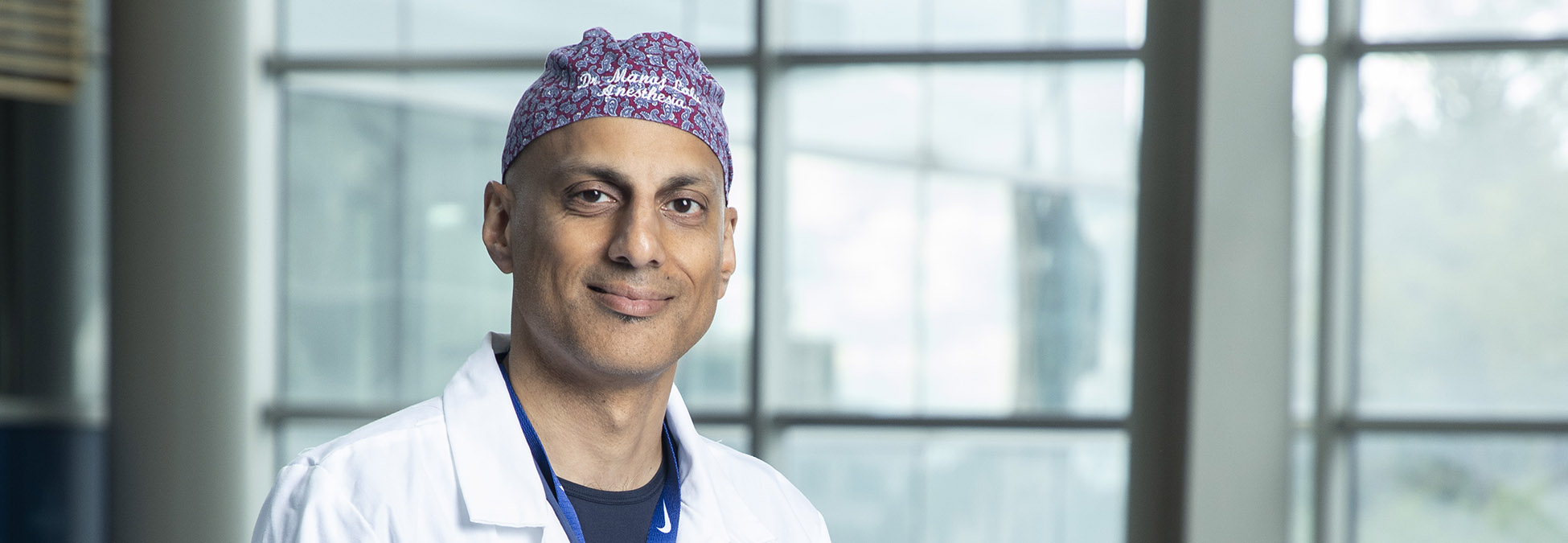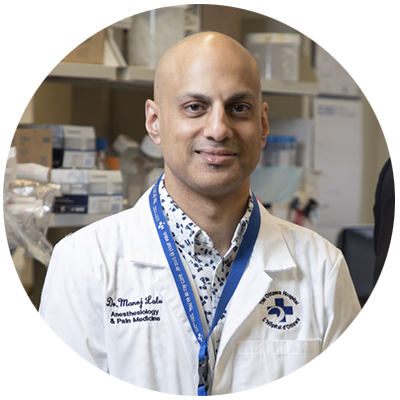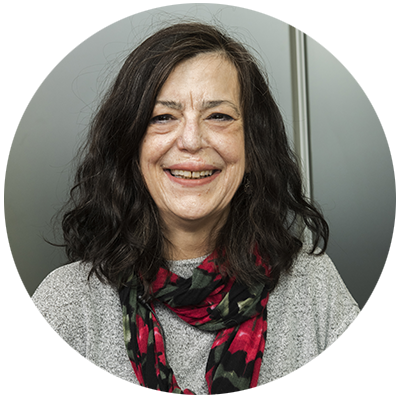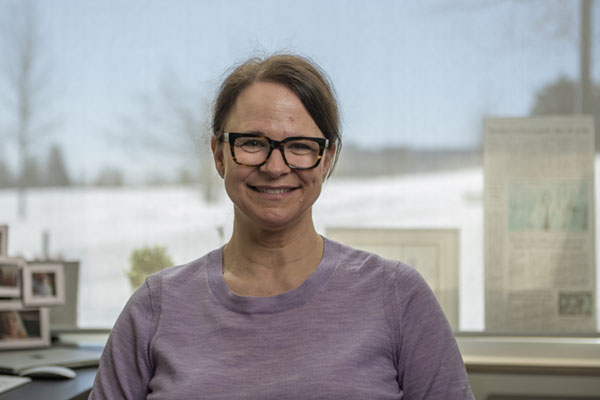
Infusing research with care
Meet Dr. Manoj Lalu, the clinician-scientist bringing lab discoveries to patients every day

Dr. Manoj Lalu is as much a juggler as a doctor, constantly balancing his roles at The Ottawa Hospital. He’s an Associate Scientist in The Ottawa Hospital’s Clinical Epidemiology and Regenerative Medicine Programs and an anesthesiologist for the Department of Anesthesiology and Pain Medicine. But Dr. Lalu’s unique position as a clinician-scientist means not only is he balancing these roles, he’s also blending them — his research is informed by his clinical work seeing patients and vice-versa.
From looking at how we can use stem cells to treat diseases like sepsis to dealing with patients directly in the ICU and OR, Dr. Lalu is making an impact behind the scenes and beyond.
Keep reading to learn what drew Dr. Lalu to The Ottawa Hospital and how he’s turning today’s research into tomorrow’s treatments.
Q: Can you tell us a little bit about your early years?
A: I was born and raised in Edmonton, Alberta, and it’s where I spent my whole childhood.
Growing up, I was mainly into music. I did piano and classical guitar for a number of years. My first paid job was actually as a back-up singer for a Christmas record.
I was also kind of a nerd; I really liked science. I liked the concrete nature of it, although what they teach you in school is quite different than what you learn when you actually start doing research; it’s a lot less clear cut in real life. I enjoyed doing experiments, and once made it to the regional science fair. I had a very simple experiment related to a pendulum, but I couldn’t compete with all these other people, who were doing things in cell cultures and other complex things.
Q: How did you get from high school science fairs in Alberta to The Ottawa Hospital?
A: I was looking for something that was biomedical in the sciences, which drew me to a Bachelor of Science in Pharmacology at the University of Alberta. In my first actual pharmacology class, we learned about all the different classes of medication and the different pathways through which they affect the body, and I thought it was so interesting.
Following my undergrad, I did a PhD in pharmacology, studying sepsis, and then did my medical degree — all at the University of Alberta. After graduation I got married, and my wife, who is also a doctor, was ready to leave Edmonton. We came to Ottawa so I could do my residency in anesthesiology in 2008.
Q: Today, you are a clinician scientist at The Ottawa Hospital, working as an anesthesiologist in the clinic and as a scientist doing research in the lab, how do these roles complement each other?
A: There is something unique that a clinician scientist brings to research. In my job as an anesthesiologist, I interact with patients, I see what the problems are in the operating room when patients are critically ill and have things like sepsis or lung injuries. Seeing things in the real world helps us decide how to proceed in the lab.
And it goes both ways. Something I’m working on a lot is “bench-to-beside” research. We have lots of different exciting findings that we have in our laboratories. That’s the bench: working with pipettes and models and cells in culture dishes. But to actually move those exciting findings — sometimes they’re therapies, sometimes they’re ways to diagnose a disease better — into clinical care, where we could actually help patients with those findings, can be a difficult and long process.
Q: Can you tell us a little bit about The Ottawa Hospital’s BLUEPRINT Excelerator and how it relates to your work?
A: The hospital’s Excelerator is a program run by the BLUEPRINT Translational Research Group, which I co-lead, in collaboration with the Ottawa Methods Centre. The Excelerator helps bridge that gap I was describing from research discoveries to clinical trials and care. It goes back to trying to apply best principles to what we know works in the clinical world.
One thing we do quite a lot of is systematic reviews, looking at all the evidence out there for a specific therapy to better understand the risks and benefits.
We also look at the barriers patients face when participating in clinical trials, the economic evaluations of therapies, or assessing criteria to assess who might do the best in a clinical trial.
These might seem like common sense things, but they’re usually not done in a systematic way leading up to all trials. We think it’s important to take this rigorous approach, and it takes time and money to able to do this kind of work.
Q: Early on in your career at The Ottawa Hospital, you worked on Christine Caron’s septic shock case. What made her case stand out, and how does it relate to the research you’re doing today?
A: I helped take care of Christine when I was a resident doctor at The Ottawa Hospital. I remember her case so clearly because it was very unique. People who are healthy, like she was, rarely respond to an infection that severely.
The issue with sepsis right now is a lot of the treatments we use are supportive — meaning we might give the patient fluids because we need to keep their blood pressure high. But what we’re trying to do in my lab, and Dr. Lauralyn McIntyre’s group, is come up with some novel therapies to help the body heal itself when it has a condition like sepsis.
Right now, we’re running a multiple laboratory study on sepsis called the National Preclinical Sepsis Platform. We’ve done multiple centre clinical trials before — those are common — but this is the first Canadian multi-lab trial, where researchers in different labs, instead of clinics, are working together on the exact same trial.

“Sepsis took so much from me — it scarred me in so many ways. We need to advocate and educate because sepsis does not discriminate.”
– Christine Caron
Q: What keeps you working here at The Ottawa Hospital?
A: The same things that brought me here: my clinical department, and The Ottawa Hospital more broadly, have been very supportive of my research. Whenever I come up with an idea, the conversation starts with “how can we make this happen” as opposed to “here are 10 reasons this won’t work.”
I also enjoy my colleagues and patients, and we do so much here that no one else in the region does. It’s exciting to work in a clinical and research environment like this.
Q: Where would we find you when you aren’t at the hospital?
A: Spending time with my family. My wife and I met through research, she was a tech at the lab across from where I did my PhD, and she’s a family doctor here in Ottawa now. We have twin girls, and they take up most of my time now. We like to travel and snowboard.
The Ottawa Hospital is a leading academic health, research, and learning hospital proudly affiliated with the University of Ottawa.


